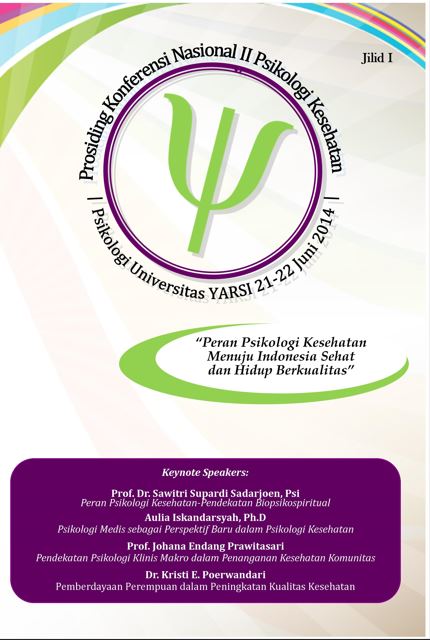HUBUNGAN ANTARA IDENTITAS ETNIK DENGAN SUBJECTIVE WELL-BEING PADA MASYARAKAT MINAHASA
Keywords:
identitas etnik, subjective well-being, MinahasaAbstract
Penelitian ini bertujuan untuk melihat hubungan antara identitas etnik dengan subjective well-being pada masyarakat Minahasa khususnya yang berada di desa Tondegesan, Tondegesan1, Pulutan dan desa Pahaleten, Kabupaten Minahasa, Sulawesi Utara. Penelitian ini menggunakan sequential explanatory-mix method melalui kuesioner kepada 90 orang responden, serta melakukan wawancara kepada 11 orang responden. Hasil dari penelitian ini menunjukkan tidak ada hubungan signifikan antara identitas etnik dengan subjective well-being pada masyarakat Minahasa (r= 0.198, p>0.05). Hal ini dapat disebabkan oleh faktor-faktor lain yang mempengaruhi kedua variabel, yaitu religiusitas dan dukungan sosial antar masyarakat yang tinggi. Hasil wawancara menunjukkan bahwa religiusitas dapat menjadi faktor yang lebih mempengaruhi subjective well-being pada masyarakat Minahasa. Selain itu juga ditemukan adanya hubungan signifikan antara identitas etnik dengan dimensi kepuasan hidup (r= 0.272, p<0.05). Hal ini menunjukkan bahwa semakin tinggi identitas etnik maka semakin tinggi kepuasan hidup masyarakat Minahasa.
References
Berry, D.S. & Hansen, J.S. (1996). Positive affect, negative affect, and social interaction. Journal of Personality and Social Psychology, 71(4), 796-809
Chow, H.P.H. (2007). Sense of belonging and life satisfaction among Hongkong adolescent immigrants in Canada [ABSTRACT]. Journal of Ethnic and Migration Studies, 33(3). Doi: 10.1080/13691830701234830
Compton, W.C. (2005). Introduction to Positive Psychology. Balmont, CA: Thomson Wadsworth.
Cuypers, K., Krokstad, S., Holmen, T.L., Knudtsen, M.S., Bygren, L.O,m Holmen, J. (2011). Patterns of receptive and creative cultural activities and their association with perceived health, anxiety, depression and satisfaction with life among adults: The HUNT study, Norway. J Epidemiol Community Health, 66(8), 698-703. doi: 10.1136/jech.2010.113571.
De Oliveira, D. R., Pankalla, A., Cabecinhas, R. (2012). Ethnic identity as predictor for the well-being: An exploratory transcultural study in Brazil and Europe. Summa Psicologica UST, 9(2), 23-42.
Diener, E., Lucas, R.E., Oishi, S. (2002). Subjective Well-being: The science of happiness and life satisfaction. In: Snyder, C.R., & Lopez, S.J., Handbook of Positive Psychology. NY: Oxford University Press.
Diener, E., Scollon, C. N., & Lucas, R. E. (2003). The evolving concept of subjective well-being: The multifaceted nature of happiness. Advances in Cell Aging and Gerontology, 15, 187-219.
Diener, E., Wirtz, D., Tov, W., Kim-Prieto, C., Choi, D., Oishi, S., Biswas-Diener, R. (2010). New well-being measures: Short scales to assess flourishing and positive and negative feelings. Social Indicators Research, 97, 143-156. DOI: 10.1007/s11205-009-9493-y.
Hassett, A.L., Maclean, R., Peterson, C., Stuart, M.R., Buyske, S., Park, N., Savage, S.V., Li, T., & Seligman, M.E.P. (2009). The observational evaluation of subjective well-being in patients with rheumatoid arthritis. Applied Psychology: Health and ell-Being, 1(1), 46-61.
Jacobsen, M. (2002). On the question of contemporary identity in Minahasa, North Sulawesi province, Indonesia. Asian Anthropology, 1, 31-58.
Onyishi, I.E., Okongwu, O.E., & Ugwu, F.O. (2012). Personality and social support as predictors of life satisfaction of Nigerian prisons officers. European Scientific Journal, 8(20), 110-125.
Phinney, J.S. (1990). Ethnic identity and adolescents and adult. Psychological Bulletin, 108 (3), 499-514.
Phinney, J.S. (1992). The multigroup ethnic identity measure: A new scale for use with diverse groups. Journal of Adolescent Research, 7(2), 156-176.
Phinney, J.S. (1993). A three-stage model of ethnic identity development. In M. Bernal & G.Knight (Eds.), Ethnic identity: Formation and transmission among Hispanics and other minorities (pp. 61-79). Albany, NY: State University of New York Press.
Roberts, R.E., Phinney, J.S. , Masse, L.C., Chen, Y.R., Roberts, C.R., & Romero, A. (1999). The structure of ethnic identity of young adolescents from diverse ethnocultural groups. The Journal of Early Adolescence, 19(3), 301-322.
Schimmack, U. (2008). The structure of subjective well-being. Dalam M. Eid & R.J. Larsen (Ed.), The Science of Subjective Well-Being (pp. 97-123). New York, NY: The Guilford Press
Smith, T.B, & Silva, L. (2011). Ethnic identity and personal well-being of people of color: A meta-analysis. Journal of Counseling Psychology, 58(1), 42-60.
Tangkilisan, Y.B. (2012). Kesenian kuno Minahasa: Dari perspektif sejarah publik. Public Historic Review, 19, 104-112.
Vinson, E.S. (2013). The impact of religiosity dimensions and ethnic identity on well-being in African American women. Disertasi, tidak diterbitkan. University of Kentucky, Lexington, Kentucky.
Watuseke, F.S. (1962). Sejarah Minahasa . Manado: Yayasan Penerbitan Merdeka.
Wenas, J. (2007). Sejarah dan Kebudayaan Minahasa. Instritut Seni Budaya Sulawesi Utara.
Internet
Badan Pusat Statistik (2010). Provinsi Sulawesi Utara. Diunduh pada 10 September 2013, dari http://sp2010.bps.go.id/index.php/site/tabel?tid=321&wid=7100000000
European Foundation for the Improvement of Living and Working Conditions. (2005). First European Quality of Life Survey: Life Satisfaction, Happiness and Sense of Belonging. Retrieved from www.eurofound.eu.int
Van Hoorn, A. (2007, April 2-3). A Short Introduction to Subjective Well-Being: Its Measurement, Correlates, and Policy Uses. Diunduh dari https://www1.oecd.org/site/worldforum06/38331839.pdf
Downloads
Published
Issue
Section
License
Copyright (c) 2025 Shintia Rahelia, Nanthida, Mega Yuliani, Debora S. Andriani, Kent Alexander, Ruth P. Sumule

This work is licensed under a Creative Commons Attribution-NonCommercial-ShareAlike 4.0 International License.

 Shintia Rahelia
Shintia Rahelia
 Fakultas Psikologi Universitas Pelita Harapan
Fakultas Psikologi Universitas Pelita Harapan



